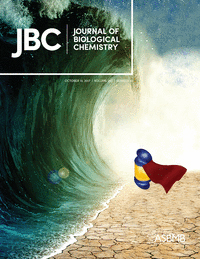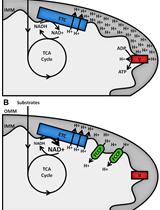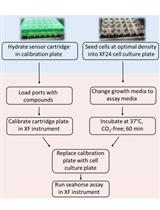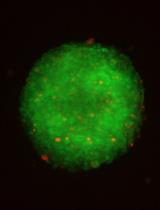- EN - English
- CN - 中文
FACS-based Glucose Uptake Assay of Mouse Embryonic Fibroblasts and Breast Cancer Cells Using 2-NBDG Probe
使用2-NBDG探针并基于FACS的小鼠胚胎成纤维细胞和乳腺癌细胞的葡萄糖摄取测定
发布: 2018年04月20日第8卷第8期 DOI: 10.21769/BioProtoc.2816 浏览次数: 11433
评审: Aswad KhadilkarChristopher J. PoonAnonymous reviewer(s)
Abstract
This is a flow cytometry-based protocol to measure glucose uptake of mouse embryonic fibroblasts (MEFs) and breast cancer cells in vitro. The method is a slightly modified and updated version as previously described (Dong et al., 2017). Briefly, the target cells are incubated with the fluorescently tagged 2-(N-(7-nitrobenz-2-oxa-1,3-diazol-4-yl)amino)-2-deoxyglucose (2-NBDG) for 2 h or 30 min, and the efficiency of glucose uptake is examined using a flow cytometer. This method can be adapted to measure a variety of adipocytes, immune cells, MEFs and cancer cells.
Keywords: Mouse embryonic fibroblasts (MEFs) (小鼠胚胎成纤维细胞(MEFs))Background
Glucose is the primary source of energy for cells. A family of glucose transporters (GLUT) is responsible for transporting glucose across cell membranes (Kohn et al., 1996). Changes in glucose uptake can reflect the changes in cellular metabolism. For example, tumor cells generally use glucose for aerobic glycolysis in order to support their rapid proliferation. Normally, tumor cells have increased rates of glucose uptake compared to normal cells (Vander Heiden et al., 2009). The 2-deoxyglucose (2DG) is a glucose analog and it accumulates in the cell as 2-deoxyglucose-6-phosphate (2DG6P). 2DG6P has been a gold standard for measuring glucose uptake for a long time (Yamamoto et al., 2011). Although the measurement of radio-labeled 2DG6P is sensitive, many researchers avoid this method because the handling and disposal of radioactive material require a special procedure.
Another non-metabolizable glucose analog is the fluorescently tagged 2-(N-(7-nitrobenz-2-oxa-1,3-diazol-4-yl)amino)-2-deoxyglucose (2-NBDG). This molecule accumulates in living cells through a glucose transporter and does not enter the glycolytic pathway. Fluorescence generated by 2-NBDG is proportional to glucose uptake. 2-NBDG fluorescence typically displays excitation/emission maxima of ~465/540 nm. It can be detected using optical filters designed for fluorescein using flow cytometry (O'Neil et al., 2005; Zou et al., 2005; Nitin et al., 2009).
Materials and Reagents
- Pipette tips 200 μl tips (USA Scientific, catalog number: 1111-1800 )
- 10 cm Petri dishes (Corning, catalog number: 430167 )
- 15 ml polystyrene centrifuge tubes (Corning, Falcon®, catalog number: 352097 )
- 5 ml round-bottom polystyrene tubes with cell-strainer cap (Corning, Falcon®, catalog number: 352235 ), 0.35 µm nylon mesh
- Embryos of C57BL/6 WT mouse (13.5 days)
- MCF7 breast cancer cells (ATCC, catalog number: HTB-22 )
- Mouse embryonic fibroblasts (MEFs)
- 0.05% trypsin-EDTA (Thermo Fisher Scientific, GibcoTM, catalog number: 25300062 )
- 2-(N-(7-Nitrobenz-2-oxa-1,3-diazol-4-yl)Amino)-2-Deoxyglucose (2-NBDG) (Thermo Fisher Scientific, InvitrogenTM, catalog number: N13195 )
- Dulbecco’s modified Eagle medium (DMEM), high glucose (GE Healthcare, Hyclone, catalog number: SH30243.01 )
- Fetal bovine serum (FBS) (Gemini Bio-Products, catalog number: 100-106 )
- Penicillin/streptomycin (Pen/Strep) (Thermo Fisher Scientific, GibcoTM, catalog number: 15140122 )
- 2-Mercaptoethanol (2-Me) (Sigma-Aldrich, catalog number: M6250-500ML )
- Sodium chloride (NaCl)
- Potassium chloride (KCl)
- Sodium phosphate dibasic (Na2HPO4)
- Potassium phosphate monobasic (KH2PO4)
- DMEM culture medium (see Recipes)
- Phosphate-buffered saline (PBS, 1x) (see Recipes)
- FACS buffer (see Recipes)
Equipment
- Pipettes (Gilson, model: P200, catalog number: F123601 )
- Refrigerated centrifuge (Eppendorf, model: 5810 R )
- Hemocytometer chamber (Hausser Scientific)
- Water bath (Fisher Scientific, model: IsotempTM 205 )
- Inverted microscope (Nikon Instruments, model: Eclipse Ts2-FL )
- Autoclave
- Cell culture hood (Thermo Fisher Scientific, Forma class II, A2)
- Cell culture incubator (Thermo Fisher Scientific, Forma series II)
- FACSCalibur flow cytometer (BD Biosciences)
Software
- FlowJo software version 10.0.8 or newer (FlowJo)
Procedure
文章信息
版权信息
© 2018 The Authors; exclusive licensee Bio-protocol LLC.
如何引用
Readers should cite both the Bio-protocol article and the original research article where this protocol was used:
- Dong, S. and Alahari, S. (2018). FACS-based Glucose Uptake Assay of Mouse Embryonic Fibroblasts and Breast Cancer Cells Using 2-NBDG Probe. Bio-protocol 8(8): e2816. DOI: 10.21769/BioProtoc.2816.
- Dong, S., Baranwal, S., Garcia, A., Serrano-Gomez, S. J., Eastlack, S., Iwakuma, T., Mercante, D., Mauvais-Jarvis, F. and Alahari, S. K. (2017). Nischarin inhibition alters energy metabolism by activating AMP-activated protein kinase. J Biol Chem 292(41): 16833-16846.
分类
癌症生物学 > 细胞能量学 > 细胞生物学试验 > 新陈代谢
生物化学 > 糖类 > 葡萄糖
您对这篇实验方法有问题吗?
在此处发布您的问题,我们将邀请本文作者来回答。同时,我们会将您的问题发布到Bio-protocol Exchange,以便寻求社区成员的帮助。
Share
Bluesky
X
Copy link














